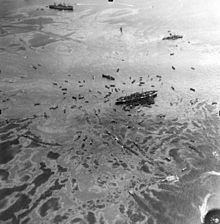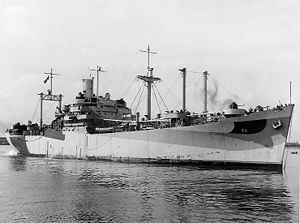Sponsored by Mrs. A. J. Reynolds Commissioned 1 July 1944 Weight 14,130 tons Beam 19 m | Acquired 28 January 1944 Launched 28 November 1943 Displacement 12.62 million kg | |
 | ||
Laid down 28 September 1943 as SS Marco Polo Builder North Carolina Shipbuilding Company | ||
USS Mount Hood (AE-11) was the lead ship of her class of ammunition ships for the United States Navy in World War II. She was the first ship named after Mount Hood, a volcano in the Cascade Range in Oregon. On 10 November 1944, shortly after 18 men had departed for shore leave, the rest of the crew were killed when the ship exploded in Seeadler Harbor at Manus Island in Papua New Guinea. The ship was obliterated while also sinking or severely damaging 22 smaller craft nearby.
Contents

History

Marco Polo was a cargo ship built under a US Maritime Commission contract (as MC hull 1356), by the North Carolina Shipbuilding Co., Wilmington, N.C..

The ship was renamed Mount Hood, 10 November 1943; launched 28 November 1943; sponsored by Mrs. A. J. Reynolds; acquired by the Navy on loan-charter basis, 28 January 1944; converted by the Norfolk Shipbuilding & Dry Dock Co., Norfolk, Virginia, and the Norfolk Navy Yard; and commissioned 1 July 1944, Comdr. Harold A. Turner in command.
Following an abbreviated fitting out and shakedown period in the Chesapeake Bay area, ammunition ship Mount Hood reported for duty to ComServFor, Atlantic Fleet, 5 August 1944. Assigned to carry cargo to the Pacific, she put into Norfolk, where her holds were loaded. On 21 August, as a unit of Task Group 29.6, she transited the Panama Canal on the 27th, and continued on, independently, via Finschafen, New Guinea. Mount Hood arrived at Seeadler Harbor, in Manus Island of the Admiralty Islands, on 22 September. Assigned to ComSoWesPac, she commenced dispensing ammunition and explosives to ships preparing for the Philippine offensive.
Disaster
At 08:30, 10 November 1944, a party consisting of communications officer, Lt. Lester H. Wallace, and 13 men left the ship and headed for shore. At 08:55, while walking on the beach, they saw a flash from the harbor, followed by two quick explosions. Scrambling into their boat, they headed back to the ship, only to turn around again shortly thereafter as "There was nothing but debris all around..."
Mount Hood, anchored in about 35 feet (11 m) of water, had exploded with an estimated 3,800 tons of ordnance material on board. The initial explosion caused flame and smoke to shoot up from amidships to more than masthead height. Within seconds, the bulk of her cargo detonated with a more intense explosion. Mushrooming smoke rose to 7,000 feet (2,100 m), obscuring the ship and the surrounding area for a radius of approximately 500 yards (500 m). Mount Hood's former position was revealed by a trench in the ocean floor 1,000 feet (300 m) long, 200 feet (60 m) wide, and 30 to 40 feet (9 to 12 m) deep. The largest remaining piece of the hull was found in the trench and measured no bigger than 16 by 10 feet (5 by 3 m). No other remains of Mount Hood were found except fragments of metal which had struck other ships in the harbor and a few tattered pages of a signal notebook found floating in the water several hundred yards away. No human remains were recovered of the 350 men aboard Mount Hood or small boats loading alongside at the time of the explosion. The only other survivors from the Mount Hood crew were a junior officer and five enlisted men who had left the ship a short time before the explosion. Two of the crew were being transferred to the base brig for trial by court martial; and the remainder of the party were picking up mail at the base post office. Charges against the prisoners were dropped following the explosion.
The concussion and metal fragments hurled from the ship also caused casualties and damage to ships and small craft within 2,000 yards (1,800 m). The repair ship Mindanao, which was broadside-on to the blast, was the most seriously damaged. All personnel topside on Mindanao were killed outright, and dozens of men were killed or wounded below decks as numerous heavy fragments from Mount Hood penetrated the side plating. Eighty-two of Mindanao's crew died. The damage to other vessels required more than 100,000 man-hours to repair, while 22 small boats and landing craft were sunk, destroyed, or damaged beyond repair; 371 sailors were injured from all ships in the harbor.
A board convened to examine evidence relating to the disaster was unable to ascertain the exact cause. After only a little over four months' service, Mount Hood was struck from the Naval Register on 11 December 1944.
List of ships damaged
The following ships were damaged by the explosion of Mount Hood:
In addition to the above ships, nine medium landing craft (LCM) and a pontoon barge moored alongside Mount Hood were also destroyed, and 13 small boats or landing craft were sunk or damaged beyond repair.
